From June 21-23, Frank is teaching a course at the TU Delft on enzyme kinetics and dynamic models of metabolism. The course information, e.g. the syllabus, can be found here Course information From Enzyme Kinetics to Models of Metabolism.
Category: Uncategorized
Maarten won a poster prize and acquired a fresh, new pair of red socks!
PhD candidate Maarten Droste is one of the recipients of the famous Red Sock Award for best poster presentation at the SIAM 2023 Conference on Applications of Dynamical Systems in Portland, Oregon. It is a tradition that each prize winner receives a pair of red socks as part of the award. His winning poster, entitled “Determinants of optimal metabolic pathway choice by microorganisms”, is co-authored by Bob Planqué and Frank Bruggeman.
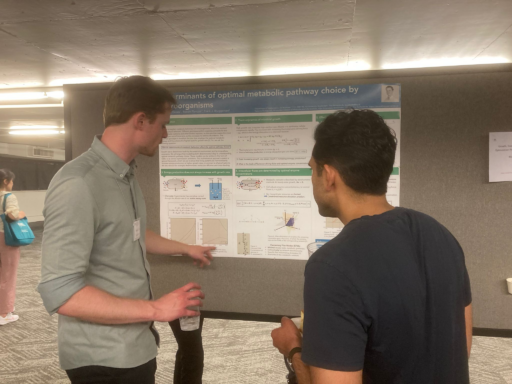
Maarten’s PhD project is all about understanding the key features and determinants of metabolic pathways choices by microorganisms, using optimality principles and mathematical models.
One of his first results is that physical systems that are alive may obey different principles than those that are inanimate. Whereas inanimate systems generally have increased fluxes (J) at higher thermodynamic driving forces (X) and therefore have a higher entropy production rate (approx. J times X), living systems may adjust their metabolism at higher nutrient concentrations in such a way that the driving force reduces but the flux – which is what matters for cell – still increases, because they swap longer for shorter pathways that only partially degrade the nutrient(s). They do this because enzyme concentration inside cells are bounded and a shorter pathway allows them to have higher enzyme concentration per reaction, and therefore a higher flux. Thus, natural selection of living microbes for growth rate that does not necessarily lead to higher entropy production, as is sometimes stated.
Another one of his findings is that optimal pathway choice depends on the concentrations of nutrients and products of metabolism. And, therefore, on the characteristics of their biotic and abiotic environment.
The abiotic effect is that the nutrient and product concentrations at the cell’s surface matter for the metabolic flux, which are determined by their values at “infinity”, diffusion coefficients, and the rates of cellular metabolism. Since the rates of cellular metabolism contribute to setting those concentrations, metabolic pathway optimization should be done with nutrient and product diffusion incorporated into the nonlinear optimization problem. Maarten has worked out this fundamental problem.
An important biotic effect also plays a role: The concentrations at the cell’s surface are also determined by the activity of other microbial species, and their relative distances, indicating that ecology matters too! Here Maarten has stumbled on a curious finding when the concentration of a product is low enough, a long pathway can have outperform a shorter pathway – even though the long pathway has lower enzyme concentrations per reaction. Whether this happens depends on the kinetics and abundance of nearby microbes feeding on this product. Thus, microbes together shape their “niche”, affecting their optimal pathway choices!
Maarten will be continuing his scientific adventures, wearing his fresh new pair of red sox!
Lab retreat in Berg en Dal
After a few years break, finally it was again time for a lab outing. In the lovely setting of Berg en Dal, we enjoyed three days (April 19th-21st) of networking and conviviality.
“Mens sana, in corpore sano” they say, so we stretched both our muscles, with plenty of biking, jeu de boules, ping pong and football, and also our brains, with the Pub Quiz and Board Games nights.
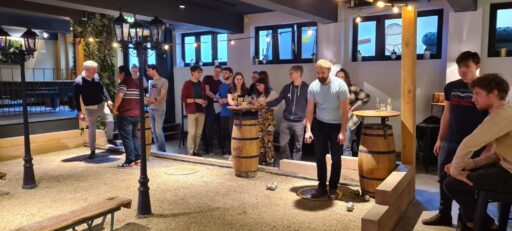
Multicultural foods and drinks (Italian and Chinese dinners, Dutch lunch and snacks, Lithuanian schnaps,…) provided the right amount of energy.
But there no real fun without some sciency science. We discussed and practised together how to effectively pitch our research interests and ideas. To practise, we split into teams and tried to promote each our own superpowered microbe. (Apparently, cuteness is the best superpower, since the furry Buddy Yeast came out as the winner.)
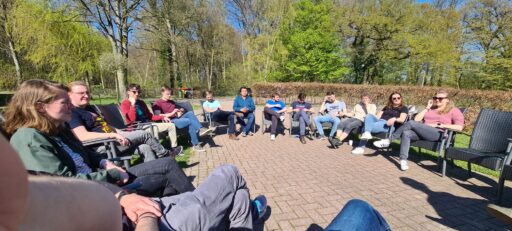
And, dulcis in fundo, on the last afternoon we crossed the German border – and a sea of sheep – riding the fietstrein!
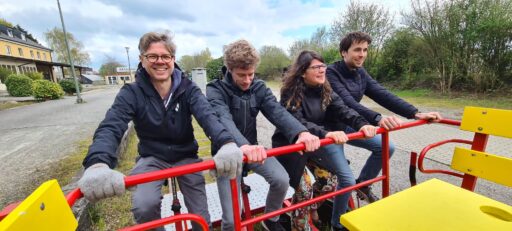
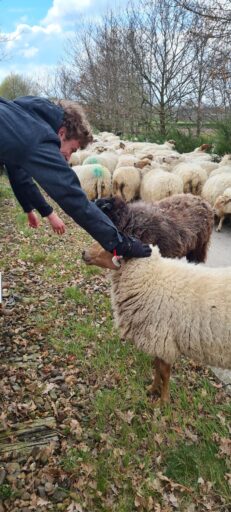
New review on spatiotemporal coupling of gene expression published
We combined our expertise in Gene expression regulation, Single-molecule RNA imaging, and Prokaryotic quantitative cell physiology to write a truly multidisciplinary review. It’s the product of a team effort by Alan Gerber (Amsterdam UMC), Sander van Otterdijk (Sysbio), Frank Bruggeman (Sysbio) and Evelina Tutucci (Sysbio).
We discussed state-of-the-art imaging approaches for the measurement and quantitative understanding of gene expression, starting from the early visualizations of single genes by electron microscopy to current fluorescence-based approaches in single cells, including live-cell RNA-imaging approaches to FISH-based spatial transcriptomics across model organisms. We also highlighted how these methods have shaped our understanding of the spatiotemporal coupling between transcription and translation in prokaryotes and the future challenges in the field.
We had a lot of fun preparing some nice figures too, which illustrate our growing interest in the spatial control of gene expression across kingdoms of life.
The review “Understanding spatiotemporal coupling of gene expression using single molecule RNA imaging technologies” is now published in Transcription (https://doi.org/10.1080/21541264.2023.2199669)
Dr. Pranas Grigaitis
Pranas successfully defended his PhD thesis, titled “Constrain and conquer: explaining metabolic strategies of microbial life through optimal resource allocation” on March 20 2023. The promotors were Bas Teusink (VU Amsterdam) and Ursula Kummer (Heidelberg); Frank Bruggeman, Jack Pronk, Maria Suarez Diez, Peter Swain, and Meike Wortel were in the thesis committee. Pranas will stay on as a Postdoc to study metabolic division of labor in ant colonies – stay tuned!
Congrats, Dr. Grigaitis!

Microbes should not change their bet when they are winning. Like you!
Together with Daan de Groot and Erik van Nimwegen, both in the Basel Biozentrum, and Age Tjalma, currently at AMOLF (Amsterdam), Frank was involved in a study on microbial phenotype switching which has recently been published in PNAS. Daan and Age previously worked in our lab.
A fundamental limitation causes microbes to continuously struggle for their survival and evolutionary persistence. They have finite biosynthetic resources for protein synthesis, including energy and intracellular space, which bounds their protein concentrations. Cellular tasks such as adaptation to new conditions and biosynthetic rates generally improve at higher concentrations of the catalyzing proteins. Thus, they cannot excel at all fitness-contributing tasks at the same time, as they trade off. This is illustrated by E. coli, which adapts poorly to new conditions when it grows fast at nutrient excess, as it expresses then mostly growth-supporting proteins instead of preparatory proteins for future conditions. It does not do so at nutrient limiting conditions. It also does not have sensors for all environmental conditions.
So, how can it then be adaptive and evolutionarily successful? They bet!
They bet in a very special way. An isogenic population of microbes, all having the same DNA, consists of individuals with slightly different behaviours (phenotypes). This is inevitable, due to the underlying stochasticity of biochemical processes — the required protein burden to overcome this does not pay off. They control this phenotypic diversity to profit from it, by controlling the phenotype switching rates, as these alternative phenotypes are each adapted to slightly different futures. Since these deviating phenotypes are not all perfectly adapted to the current environmental state, having too many maladapted ones is a fitness cost. How can a microbial genotype (a species) cope with this?
Well, the fast-growing phenotypes resemble the best bets and should not switch to another phenotype. Thus, in a population of isogenic microbes the fast growing ones should have a lower switching rate than those that perform less well.
Microbes should, after all, not change their bet when they are winning! Like we do!
In our recent PNAS paper, we performed a general theoretical analysis of the fitness benefit of this growth-rate dependent strategy of phenotype switching. This had not been done before.
We found that reduced phenotype switching rates as function of growth rate has an enormous fitness advantage. We expect therefore that this has evolved often, across microbial species. And since this does not involve active sensing of the environment, it is likely a potent adaptation strategy across many different environmental conditions. Indirect physiological evidence of E. coli also points into the direction that it exploits this strategy.
Jurgen got a project funded in the ZonMw Open Competition
Jurgen Haanstra received a 750k€ grant in the ZonMw Open Competition together with Ruud Brakenhoff from Amsterdam UMC-Cancer Center Amsterdam (A-UMC-CCA). The ZonMw open competition funds research proposals for non-programmed, fundamental research. Through this, ZonMw wants to bring together researchers from two or more disciplines to facilitate excellent team science that results in groundbreaking research of exceptional quality in the field of healthcare.
The project of Jurgen and Ruud will focus on metabolism in head-and neck cancer. Head and neck cancer arises in the mucosal linings of the upper-aerodigestive tract and is generally preceded by precancerous changes that may be visible as lesions. In total 50% of patients die of the disease despite invasive treatments. We recently discovered that these tumors rewire their metabolic program atypically. In this project they will use computer models and laboratory experiments to study this atypical metabolic program. They will investigate why these tumor cell reprogram metabolism in this remarkable way, and how this can be exploited to improve diagnosis and treatment of these tumors and their preceding precancerous mucosal changes.
New Insights In Wine Yeast
Nitrogen limitation found as reason for lactate production
Nitrogen composition determines the amount of lactate produced by yeast Lachancea thermotolerans in wine fermentations. Here we describe this phenomenon for the first time in the journal Food Microbiology. Knowledge about the role of nitrogen in the fermentation process of wine with yeast Lachancea thermotolerans may lead to improved wine fermentations.
Lactate in wine fermentations
The amount of sugar in grapes increases due to increased temperatures. When sugar gets fermented in wine fermentation, the main product is alcohol. Therefore, higher build up of sugars in grapes is leading towards an increased alcohol content in wine. These disturbances in grape production ask for new innovations within the wine fermentation to produce good quality wine. A promising species in wine fermentations is the yeast Lachancea thermotolerans. This specific yeast ferments the sugar from grapes into both lactate and alcohol, leading to a lower final alcohol content.
Before I started my PhD, Chrats and colleagues were studying the lactate production of Lachancea and noticed something peculiar. Lactate was not produced throughout the fermentation, but the production only started after a specific point in time. What’s more, this observation varied per Lachancea strain. An exhaustive search into the strain differences and the cause for lactate production is what followed.
Multidisciplinary learning curve
Fortunately, my new colleagues from Teusink Bruggeman Lab are no stranger to finding answers to complex biological questions. Therefore, a mirage of data were generated, ranging from growth studies, genomics, transcriptomics and metabolomics in order to unravel this unique phenotype. This is where my journey started, overloaded by data and with the need to perform multidisciplinary research.
Feeling a bit overwhelmed at first, I was glad to start putting the pieces together with some help. When it comes to bioinformatics I had the full support from Chrats. I was looking for a needle (the reason for lactate production) in a transcriptome stack. After hours of coding in R, Chrats and I came up with a pipeline to analyze the data in an organized manner. This gave us valuable hints on the location of our needle, yet the specific reason for lactate production remained elusive.
Christmas presents
When it comes to studying metabolism of a new species, kickstarting this process can be done with genome-scale metabolic models. Some would call these models a fancy book-keeping tool for metabolism. Together with the help of my supervisor, Bas, and an experienced colleague, Sebastian, we constructed the very first model for Lachancea.
After months of analysis, coding, more analysis, more coding, and discussing the lot, we were able to deduce that nitrogen must be the only limiting factor when lactate was starting to be produced! Finally I could take our brand new hypothesis back to the lab! Between Christmas and New years eve, when the lab is at its quietest, we gave Lachancea some additional nitrogen. Like a Christmas present, the nitrogen influenced the lactate production as expected. To fit the last pieces of the puzzle we contacted our collaborator from Chr. Hansen, Ahmad Zeidan. Lars Schreubers, measured the nitrogen content and with that we verified our hypothesis.
This led to the conclusion that Lachancea thermotolerans only start to produce lactate when nitrogen becomes limiting.
Author: Julius Battjes
Publication: https://doi.org/10.1016/j.fm.2022.104167
Pint of Science event hosting Avis as a speaker!
After two years of online events, Pint of Science is back in your local pub! Pint22 will be hosting Science talks from May 9-11 and you will be able to enjoy mind-blowing scientific talks with a cold beer at your local bar in Amsterdam. The program of this year includes talks about laboratory meat, plant-based fermented foods, intrusive thoughts and how to create synthetic life. Avis from our group will be one of the speakers, so don’t miss it! You can register for the events here.
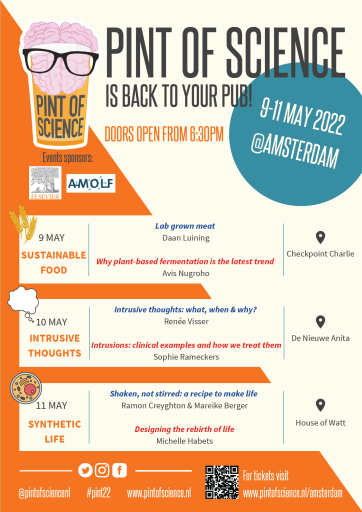
A new paper published on optimal H ATP synthase expression in E coli
We recently published a new paper, https://febs.onlinelibrary.wiley.com/doi/10.1111/febs.16401. Below you find a short reflection on this paper.
Microbial behaviour has been shaped by evolution. Our understanding is that the best adapted genetic variants are outcompeting the others — which explains their frequency increase and their selection. These fit variants generate novel genetic variants, which perform even better, equally good or worse. So perhaps we can rationalise the behaviour of microbes from the viewpoint of fitness maximisation by natural selection? More specifically, maybe we can understand phenotypic adaptations, e.g. protein expression, of particular microorganisms as fitness-maximising adaptations?
At least two problems are associated with this view. The first problem is that fitness of a genotype is related to the performance over a long period. Fitness may therefore not be measurable at one particular moment in time. Instead, we should take the evolutionary history into account — recreate it somehow in the lab—, but these conditions we do not know. So assessing the fitness of a microbe is perhaps not so straightforward and fundamentally impossible? A second problem is that the winning genotype may not be close to an optimal fitness, it was after all merely better than its competitors and not necessarily optimal. How then can we make sense of microbes in the light of fitness?
In a recent paper, we took a very simple, perhaps-ignorant approach. At the outset we realised that: i. long-term fitness over a particular period equals the time-averaged growth rate over that period and ii. growth rate depends on metabolic protein concentrations that are limited by biosynthetic constraints. One corollary of this is that expression of unneeded proteins should reduce the immediate growth rate and another is that an optimal, immediate-growth-rate maximising protein expression level exists for needed proteins. Both have been experimentally verified.
However, this optimal expression level maximises the immediate growth rate, which is not necessarily a strategy for long-term fitness (average growth rate) maximisation — which is what truly matters in evolution.
This was our simple idea: We assumed that Escherichia coli does not have a recollection of its precise environmental history and generally lives in unpredictable environments. Given this, it made sense to us that E. coli may strive for long-term fitness maximisation (average growth rate maximisation) by maximising its immediate growth rate by optimal expression of metabolic proteins. An implicit hypothesis was that biochemical regulation can optimise metabolic systems, for which we had obtained theoretical evidence already. Finally, we were aware of literature showing immediate-growth-rate-maximising expression of particular other proteins. What was not known is whether cells can do this robustly, so across a great many conditions — representing an unpredictable environment.
To test this, we took a protein that is ubiquitously expressed and expensive for the cell to make: its membrane embedded FoF1 ATP-synthase, which makes ATP at the expense of the proton motive force, which is maintained by oxidative phosphorylation. This process is the only ATP synthesising step when ATP is not made via substrate-level phosphorylation in glycolysis. So during growth on gluconeogenic carbon sources. Since the growth rate on those carbon sources greatly varies, the ATP demand per unit time will too, and therefore the needed level of ATP-synthase may vary accordingly. We tested 28 different conditions and we found that in all cases the expression level of this vital protein lies within a few percent of the optimal level that maximises the immediate growth rate. So, an E. coli cell has a growth-rate-maximising expression level of its ATP synthase.
This work is intriguing and puzzling at the same time. In biology, we rarely know the objective of molecular control systems. That objective may be ultimately related to the performance of the organism, but how it relates to that is often not understood. Here we found such an objective: expression regulation of ATP-synthase has growth-rate maximisation as its objective. How it achieves this is not understood, but the regulation of other systems points to possible mechanisms. What’s puzzling is how our results can be reconciled with seemingly conflicting data indicating that other metabolic proteins may be over-expressed, such as enzymes in lower glycolysis and the overcapacity of the ribosome? Is this occurring because cells can then faster transit to new conditions? Why is this not the case for ATP-synthase, which is likely also needed during transitions? Or are those cases not really cases of overexpression, but is having a low v/Vmax ratio actually the optimal behaviour required for immediate growth rate maximisation? On all of these questions, the field does not yet have satisfactory answers.
Before this study, one could have argue that the fitness-maximisation question cannot really by answered because we do not know the evolutionary history, but this study (and others) suggests that perhaps many regulatory aspects of bacteria boil down to immediate fitness maximisation, because they live in such unpredictable environments. Perhaps their best bet on a high long-term fitness is to bet on immediate fast growth.
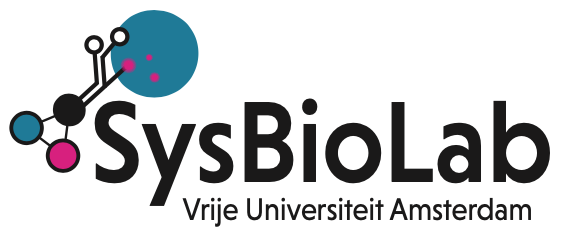
Recent Comments